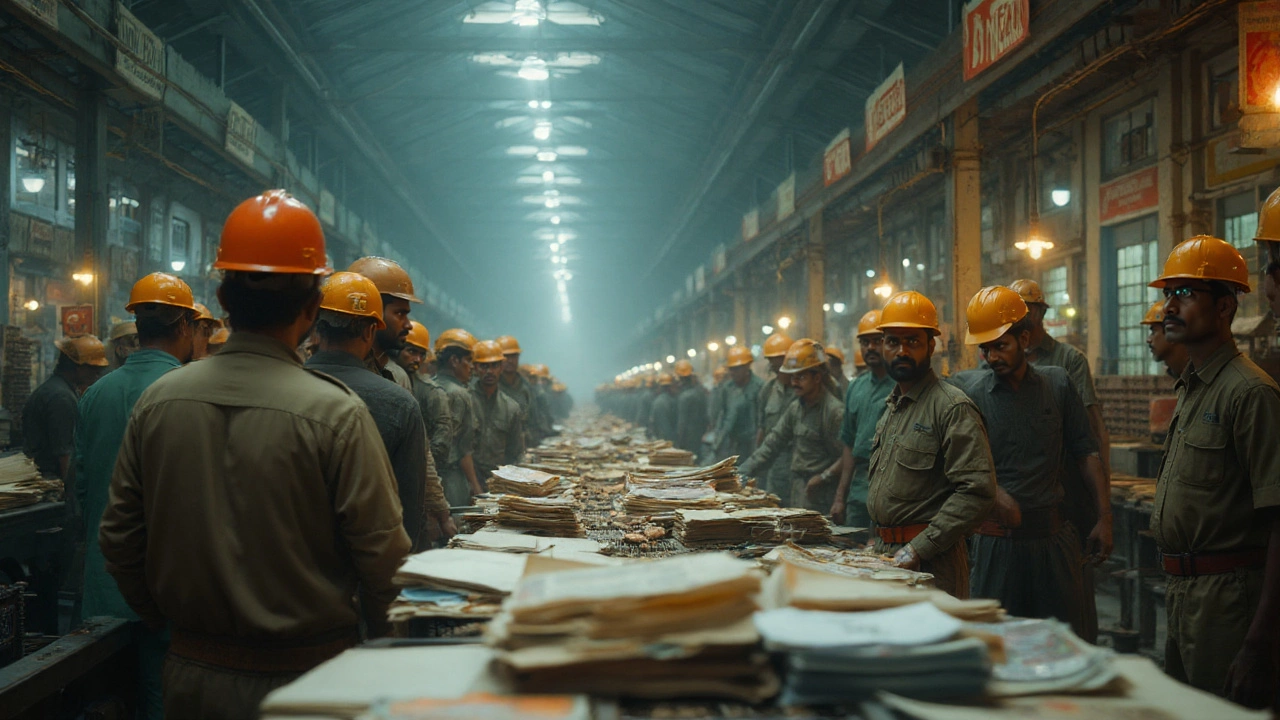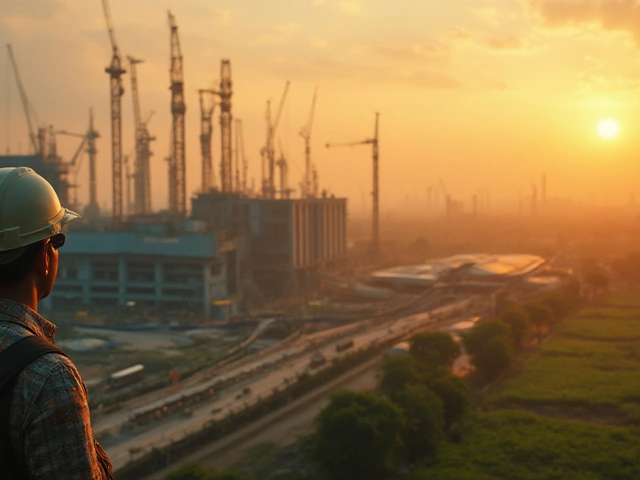Picture this: a country with the world’s largest youth population, 500 million smartphone users, and a government chanting ‘Make in India’ with the gusto of a cricket stadium crowd. But when you actually peek under the hood, India’s manufacturing sector is sputtering more than roaring. Even with all this promise, manufacturing’s share of India’s GDP has barely budged in the last decade, hovering around 15%. If you expected factory floors bustling like in China, reality might feel like a punch to the gut. So, what’s holding back this sleeping giant?
The Dream vs. Reality: Where Manufacturing Stands in 2025
Back in 2014, the ‘Make in India’ campaign launched to wild applause. The goal? To boost manufacturing’s share of GDP to 25% and create 100 million jobs by 2022. Fast forward to 2025, and the numbers are, frankly, a bit embarrassing. Manufacturing is stuck at about 15% of India’s GDP, far behind China (27%), Vietnam (24%), and even Bangladesh (19%).
So, why this gap between ambition and achievement? For starters, India’s manufacturing exports have limped along. Electronics, for example, should have exploded. Instead, India still imports 88% of its components for smartphones, despite assembling millions domestically. Auto, textile, and pharma manufacturing do better, but they too face serious headwinds from costs, compliance issues, and global competition. If we look at job creation, the letdown gets clearer. Only around 4 million jobs have been added in formal manufacturing since 2014—way less than what was promised. The pandemic in 2020 made things even worse. Factories shut, workers migrated back to villages, and the sector saw a mini-exodus. Even after the world has started running again, contract jobs, automation, and a reliance on low-wage workers mean reliable, well-paid manufacturing careers are still rare.
| Country | Manufacturing % of GDP (2024) | Manufacturing Jobs Created (2014-2024) |
|---|---|---|
| China | 27% | +33 million |
| Vietnam | 24% | +8.2 million |
| Bangladesh | 19% | +4.3 million |
| India | 15% | +4 million |
Critically, big companies dominate most of the growth, but India’s 63 million small manufacturers struggle to scale. They want to hire and expand, but face a jungle of complicated regulations, hard-to-navigate financing, and endless approval processes. This isn’t about lack of ambition—the hurdles are real and everywhere. If a small business owner spends more time filling out forms than running his shop, you’ve got a serious problem. Meanwhile, digitalization and supply chain modernization haven’t caught on fast enough, so India tends to lose out on large global contracts to slicker competitors in Southeast Asia.
Key Roadblocks: Why Does Manufacturing Struggle?
If you talk to factory owners in Pune or Chennai, you’ll hear a familiar chorus of frustration. Most stories boil down to five big headaches: land, labor, logistics, laws, and lost investment. Let’s pull these apart.
Land is expensive and hard to get. Industrial land in India costs almost ten times more than in Vietnam or Indonesia. That’s not just about price—the paperwork can drag on for years. In Maharashtra, for example, it can take 12 months to legally acquire land, compared to just weeks in Singapore. Add in messy property titles and local disputes, and projects get stuck before they start rolling.
Next, labor laws still scare away investors. India has over 40 national labor laws and hundreds at the state level. Hire more than 100 people, and suddenly, you’re buried in red tape. Many factories avoid expansion just to stay under this threshold. Plus, finding skilled workers remains tough. Government reports say only about 15% of India’s workforce has formal skill training. That’s why, even as millions of young people hunt for work, factory owners still can’t find what they need.
Then there’s infrastructure. Sure, the government shows off gleaming highways and some new ports, but the details tell a different story. India’s average logistics cost gobbles up about 14% of GDP—compared with 10% in China and just 8% in Germany. Power cuts, patched-up roads, and overloaded trains slow down everyone. A broken delivery chain means companies pay more and wait longer, forcing them to hold more stock and lose money.
Complicated taxes and compliance are another killer. Despite the arrival of GST (Goods and Services Tax), anyone in manufacturing still spends tons of time dealing with inspectors and paperwork. Delays cost money. Bureaucracy can get so intense, some business owners pay small bribes just to get basic permissions quickly. Foreign companies, who have choices about where to invest, often walk away.
And let’s not forget investment. Big global players—in electronics, semiconductors, and advanced engineering—still hesitate before building in India. Why? The lure of cheap labor isn’t enough anymore. Other countries offer smoother land deals, less red tape, and real tax support. A survey by the Confederation of Indian Industry in late 2024 showed that 68% of Indian manufacturers believe government incentives aren’t enough to make India globally competitive.

Opportunities Waiting to Be Tapped
It’s not all doom and gloom. India’s market is gigantic—right now about 1.43 billion people. Domestic consumption is a serious engine for growth. Sectors like automobiles, renewable energy, defense, and toys show signs of taking off. For example, India is now the world’s third-largest car market and the second-largest mobile handset manufacturer, at least for assembly.
Here’s the kicker: India’s got a chance to grab the jobs and contracts that China is slowly letting go. Global companies want alternatives, especially since pandemic supply shocks. So they’re “China+1”-ing, looking for places to set up plants outside China. India has started attracting some big names—Apple started assembling the newest iPhones in Chennai, and Tata Group has announced plans for a domestic chip fab. There’s hope in the air if India can get its act together.
The Indian government isn’t sleeping through all this, either. The Production Linked Incentive (PLI) schemes launched in 2021 now cover 15 industries. These paid out roughly $5 billion to encourage domestic and foreign factories to set up shop in India. States like Gujarat and Tamil Nadu roll out red carpets for investors with easier approvals and dedicated zones. In 2024, India’s solar equipment manufacturing grew by 68%, the fastest in any segment.
Talent is also changing. Technical education enrollments in India have bounced back, thanks to more online upskilling and industry tie-ups. Companies like Siemens and Bosch now train thousands of local workers in high-tech manufacturing every year.
| Sector | 2022 Output Growth | 2024 Output Growth |
|---|---|---|
| Automobiles | +12% | +15% |
| Renewables | +25% | +32% |
| Mobile Manufacturing | +48% | +56% |
| Textiles | +4% | +5.5% |
| Pharma | +7% | +6% |
But let’s be real—these are bright spots, not tidal waves. Job creation is still way below potential, and upgrades to roads, ports, and logistics hubs move at a crawl. Skill-building isn’t universal. For many rural factories, recruiting certified welders or machine operators remains a fantasy, not reality.
So, is there a silver bullet? Maybe not. But focusing policy on proven winners—like electronics, green energy, and auto components—can help. Local sourcing, better logistics, real physical infrastructure, and simpler tax laws are what will tip the scales. The most successful states are the ones that act less like gatekeepers and more like welcoming partners.
What’s Next? Steps for a Manufacturing Comeback
Every Indian entrepreneur wants to know: What actually works? How do you avoid the endless hurdles and get things moving? Here are a few ideas and tips drawn straight from business veterans and sector studies.
- Find reliable partners: Successful Indian manufacturers often start with a local partner who knows the tricks to getting things done on the ground. That means faster permits, better networks, and less wasted time.
- Lean into learning: Upskill your workforce constantly. If you can’t hire experts, train apprentices inside your own factory, or tap into government and private upskilling programs. Chatbots and digital platforms can help teach everything from CAD design to machine maintenance.
- Automate where possible: With rising wages and labor shortages, automating simple tasks boosts both quality and profit. SMEs in Pune who adopted basic robotics between 2021 and 2024 saw up to 22% fewer defects, according to a FICCI survey.
- Play the incentives game: Stay updated on central and state government incentives—subsidies, tax breaks, and direct PLI cash. These can tip the balance for launching a new unit or scaling up.
- Invest in digital logistics: Track inventory with QR codes, monitor supply chains over cloud-based dashboards, and use GPS and even drones for inventory and shipment tracking. It sounds fancy, but even tiny units in Coimbatore are trying it now.
- Expand globally, start regionally: Indian manufacturers do better when they first dominate their own region before exporting big. Look for gaps in ASEAN markets or Africa, where demand is rising and competition is less fierce than Europe or the US.
If you run a factory or want to start one, nothing matters more than cutting complexity and staying nimble. Demand is there—the Indian consumer is ready to buy. The challenge is moving from talk to action.
So, what’s really holding back manufacturing in India? It’s not just one thing. It’s a crazy mix of outdated rules, slow infrastructure, red tape, and a lack of skilled hands. Yet, there are obvious fixes and loads of room to grow, especially for those willing to hustle, adapt, and get inventive. Will India ever match China’s factory power? That’s unclear. But if there’s one country with the energy to prove the world wrong, it’s this one. Next time you buy ‘Made in India,’ know that real people fought hard to make that label possible—and the battle to ramp up is still on.





